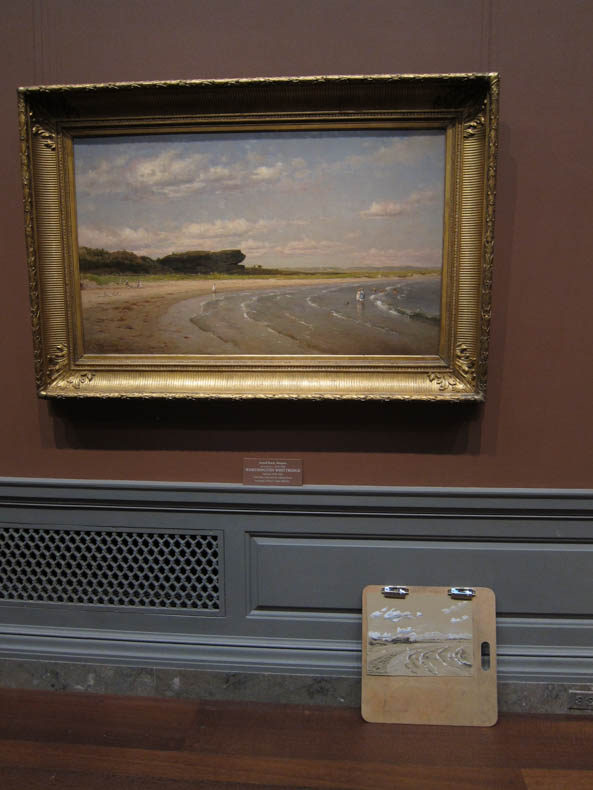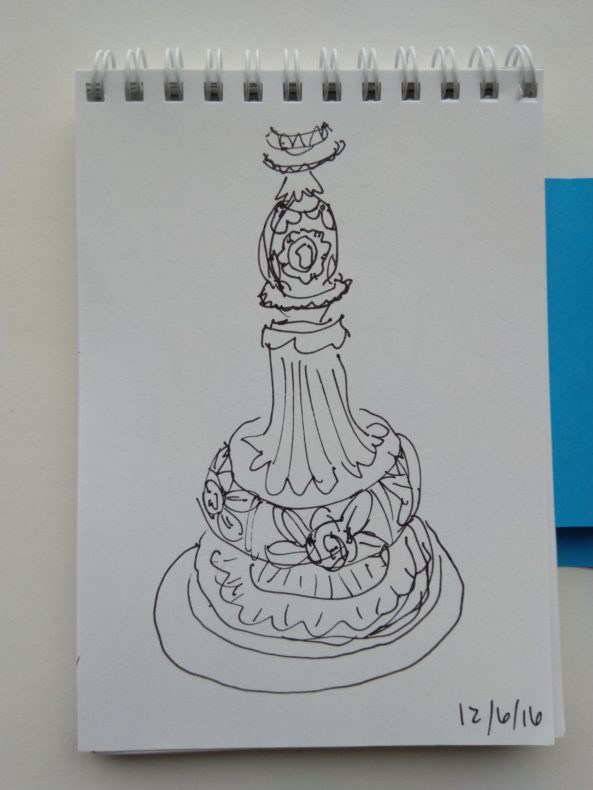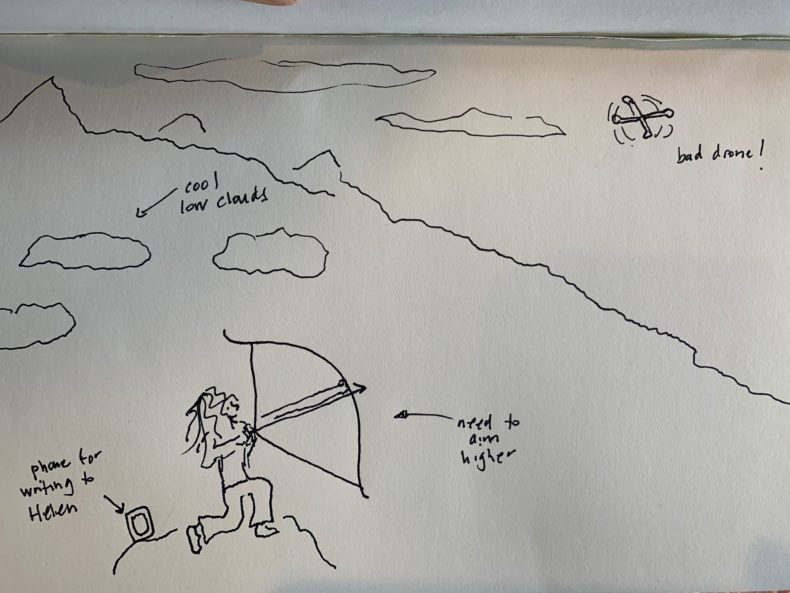
Cameron: Helen! It is I, the high school state debate champion of 2009, here to have another vicious argument with you. Although there are many things about that sentence that are not true, and even grammatically incorrect.
Helen: Oooooh this is exciting. And slightly scary.
Cameron: Don’t worry, I am not going to argue with you using all my scary debate skills today. I wanted to ask you about art because I love seeing the work that you put on Instagram (and you had an art show last fall!) but I’m interested in it as it relates to writing. How do you decide when you’re going to draw something? Do you get a drawing feeling? I am feeling like I should draw more, but I sort of don’t know when or how to start. Like I don’t know how it feels to want to draw something.
Helen: I do get an “I want to draw something” feeling. It’s sort of an itch. “Mmmm sure would like to be putting some lines on some paper right now.” It’s not because I see a thing I want to draw; often there isn’t anything I really feel like drawing. When I get the feeling at home, sometimes I’ll draw one of my lamps again – I have a lot of drawings of my lamps – or maybe I’ll draw some kind of comic, or maybe I’ll text a friend and ask if she wants to go plein air drawing this weekend.
There was a year there where I drew every day , and that year I would often get an “oh crap it’s bedtime and I haven’t drawn anything yet” feeling. I kept a sketchbook and pen in a drawer so I could do a 15-second drawing of my lamp and fulfill my daily drawing obligation without even getting back out of bed.

Cameron: Going outside and doing drawing sounds nice. That’s the only time I feel like I draw, when I’m camping or hiking with someone who doesn’t mind or is also drawing. I didn’t know you could draw for 15 seconds and that counted! That seems more manageable. Drawing sometimes seems like a production.
Helen: Oh it totally counts! A friend of mine who drew every day for a year found it super annoying and onerous because she was doing all of the drawings in the same sketchbook. My rule was just that I had to draw something during that day, and it could be in the notebook in my bag or in the margins of a meeting agenda or in that sketchbook that lived in my bedside drawer – it all counted.
Every time you start a drawing, the goal doesn’t have to be to make an amazing work of art or to perfectly record what’s in front of you. It can just be to squiggle some lines around and have fun looking.
Cameron: I could definitely squiggle some lines around, because that doesn’t sound like actual drawing, it sounds like fun. Actual drawing seems intimidating.
Helen: Drawing is intimidating. There’s a thing with writing that you are certainly aware of, that you get to a point in writing almost anything where you’re like, “omg this is terrible what was I thinking writing is so hard I’m the worst at it why did I ever think I could make a living at this” and then, if you keep going, eventually it comes out fine.
It turns out drawing is the same way – with most drawings there’s a point where I can look at it and be like “ugh.” Everything’s all wonky and out of balance, and it doesn’t look like the thing in front of me at all, and I hate it. And, also, if I keep going, most of the time it’ll turn into something I like.
With writing, I had to learn that this stage was temporary. So when I started encountering the same feelings with drawing, I eventually caught on that this miserable feeling was temporary. And that, if I kept going, it might get better.
In December 2014, more than a year before my year of drawing, I went to a Drawing Salon at the National Gallery of Art here in DC. They’re these wonderful events where an artist tells you about a certain era or artist, and they lead you through a series of exercises that help you look at the art. The last exercise is always a longer one, where you look at a single artwork. The goal is to look deeply at the art, not to make a beautiful thing, but I can’t help wanting to make something nice, too.
For that last exercise, I was working on a painting by Worthington Whittredge. It’s a landscape, a beach with a nice curving coastline. They provide the art supplies, and I was using fancy artist crayons on gray paper. I’d been working on it for a while and it looked like garbage. I felt disappointed, and sort of embarrassed that I’d thought it was even worth trying. The artist came by, and he or she, I forget which, told me to take my white crayon and add the little whitecaps along the edges of the waves. And then, suddenly, it looked like something. It even kind of looked like the painting. It was this amazing transformation.
That was when I started to learn that drawing has the same kind of miserable troughs as writing, and also when I started to think, huh – if I practiced at this, would I get better at it?
Cameron: It’s really amazing how little things like that (like the whitecaps) make a big difference. And also how funny (I don’t know if funny is the right word) that drawing or writing can make you go through this range of extreme emotions over the course of a few minutes. Like, “This is shit! I’m the worst ever! Why do I even do this! Ok, well, keep trying anyway. And…oh! There’s something there. Like the tiniest little sparkle.” I mean, I guess that’s the satisfying part, the moment where something turns from being awful to being sort of interesting and curious and even maybe having a little glimmer of…something. Potential. Or meaning.
Helen: It’s so funny, isn’t it? They’re such big emotions! Over whether or not my crayon drawing looked like the oil painting painted by a professional oil painter who is in the National Gallery! But gosh, I just felt like such a miserable failure. And then such a success when it worked out!
A big part of doing the thing where I drew every day was convincing myself that it didn’t matter if I did a bad drawing. I had to lecture myself quite sternly. “Who is hurt if you do a bad drawing! Nobody! Just do it! It’s harmless!” and then most of them turn out to be not that bad, and what is “bad” anyway?
Cameron: I’m starting to feel like I should go draw something now. There has been a drone flying over my head while we’ve been talking, and I want to draw a picture of me shooting it with a big bow and arrow. That sounds very therapeutic. And if I start to feel bad about it, I’ll tell myself what you just said–who is hurt if you do a bad drawing! If only it could be the drone.

*
Images by Helen Fields and Cameron Walker!
Cameron, my daughter was feeling like she wanted to start drawing again. I stumbled across a “drawing prompts” notebook in B+N and bought it for her on a whim. It’s about 5×7 and each page has one or two phrases on it (e.g. “a polka dot bow-tie”, “a flower”, “a bee buzzing around someone’s head”). When she gets the urge to draw, she flips it open and skips through the pages at random until something lights up her imagination. Then she draws that. She’s been drawing practically every day since. Have fun!
Dr. D, one of my favorite things to do is to buy new notebooks–I will look for it!
Ohoh. I found it! This is the one. She *loves* it and even carries it with her to work to draw in on her breaks.
https://www.barnesandnoble.com/w/300-drawing-prompts-piccadilly/1121239703?ean=9781620098516#/
Three cheers for Dr. D! It is on the way! I’m excited!